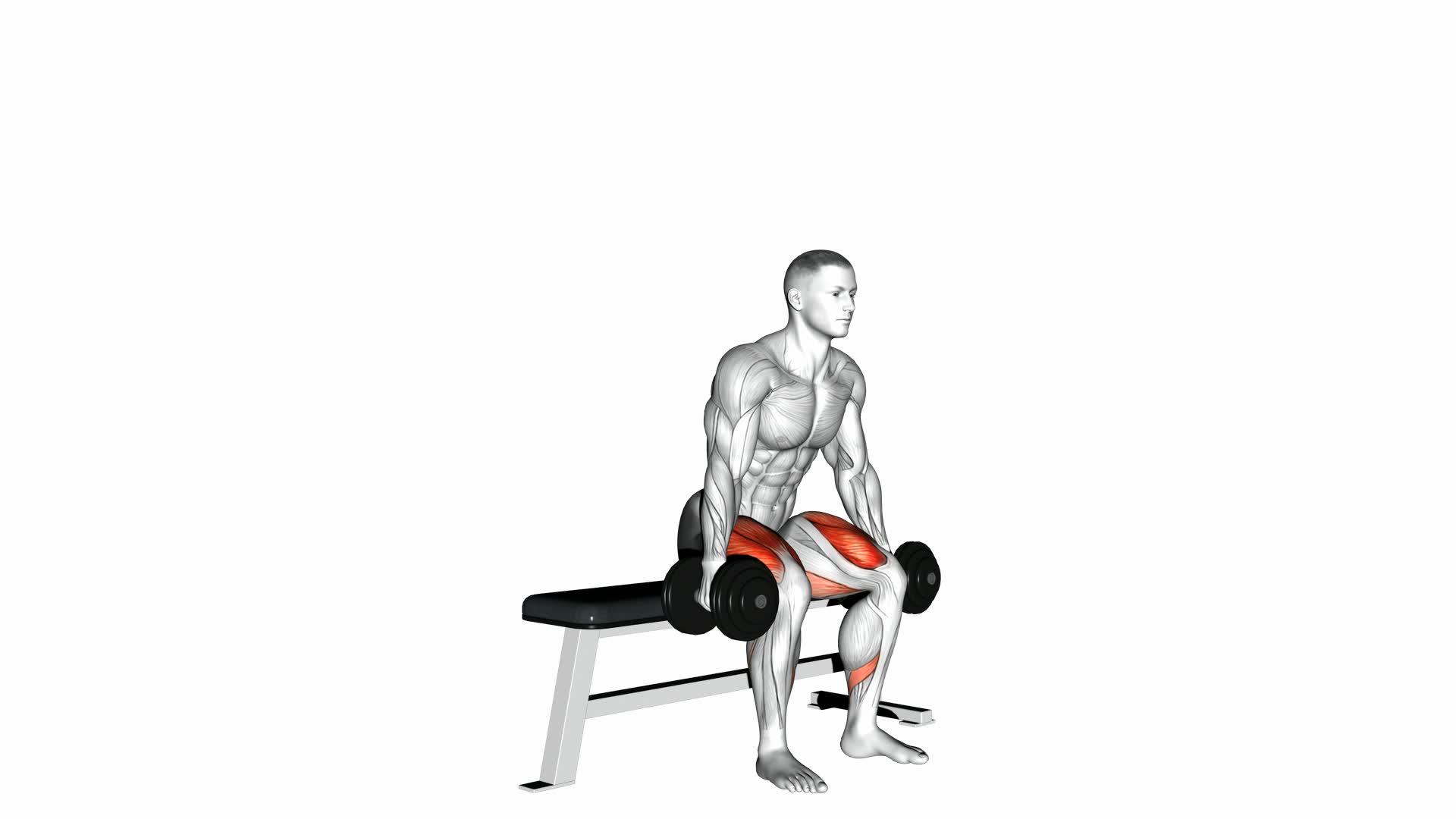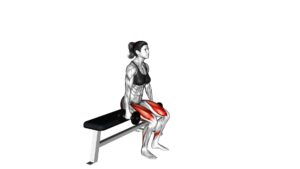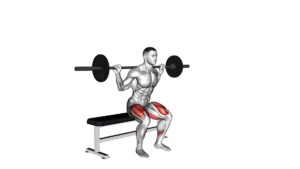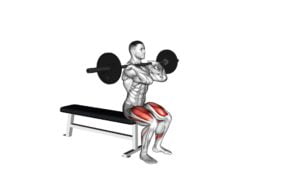Dumbbell Bench Squat – Video Exercise Guide & Tips

Are you looking to tone your lower body and build strength? The dumbbell bench squat is the perfect exercise for you.
Watch This Exercise Video
In this video exercise guide, we will show you the proper form and give you helpful tips to get the most out of this workout. Whether you're a beginner or advanced, our variations and intensity-boosting tips will challenge you.
Get ready to squat your way to a stronger, more toned physique. Let's get started!
Key Takeaways
- Dumbbell bench squat increases stability, support, and range of motion.
- Proper form and technique are crucial to avoid common mistakes and prevent injuries.
- Variations and intensity enhancement techniques can target different muscle groups and make workouts more challenging.
- Safety precautions, appropriate equipment, and gradual progression are important for a safe and effective dumbbell bench squat.
Benefits of the Dumbbell Bench Squat
You can experience significant strength gains by incorporating dumbbell bench squats into your workout routine. Dumbbell bench squats are a variation of the traditional squat exercise that can provide numerous benefits for your lower body and overall fitness.
One of the main advantages of incorporating dumbbell bench squats is the increased stability and support they offer. By using a bench as support, you can maintain proper form and focus on engaging your leg muscles more effectively.
Dumbbell bench squats also allow for a greater range of motion compared to regular squats, which can help to activate more muscle fibers and promote better overall muscle development. Additionally, this exercise targets multiple muscle groups, including your quadriceps, hamstrings, glutes, and calves, making it a highly efficient way to work your lower body.
To increase the intensity of your dumbbell bench squats, you can try various variations such as goblet squats or single-leg squats. These variations can challenge your stability and engage different muscle groups, leading to even greater strength gains. It's also important to gradually increase the weight of your dumbbells over time to continue challenging your muscles and promoting growth.
Incorporating dumbbell bench squats into your workout routine can provide a valuable addition to your lower body training. By focusing on proper form, gradually increasing intensity, and incorporating different variations, you can maximize the benefits of this exercise and achieve significant strength gains.
Proper Form for the Dumbbell Bench Squat
To perform the dumbbell bench squat with proper form, focus on maintaining stability and engaging your leg muscles effectively. Here are some key tips to ensure you're performing the exercise correctly:
- Start by sitting on the edge of a bench with your feet flat on the ground and your knees bent at a 90-degree angle.
- Hold a dumbbell in each hand, resting them on your shoulders with your palms facing inward.
- Engage your core and keep your back straight as you push through your heels to stand up, extending your legs fully.
- Slowly lower yourself back down to the starting position, keeping your knees in line with your toes.
- Repeat for the desired number of repetitions.
By following these guidelines, you'll maximize the benefits of the dumbbell bench squat, which include:
- Strengthening your quadriceps, hamstrings, and glutes.
- Improving lower body stability and balance.
- Engaging your core muscles for added support.
To add variety to your workout routine, you can try different variations of the dumbbell bench squat, such as:
- Goblet squat: Hold a single dumbbell vertically in front of your chest.
- Bulgarian split squat: Elevate one foot behind you on a bench while performing the squat with the other leg.
- Sumo squat: Position your feet wider than shoulder-width apart and turn your toes outward.
Common Mistakes to Avoid
To ensure proper form and prevent injuries during the dumbbell bench squat, there are a few common mistakes you should avoid.
First, make sure that your knees don't cave inwards during the squat, as this can strain the joints.
Additionally, avoid rounding your back or lifting your heels off the ground, as this can put unnecessary stress on your spine.
Form Correction Tips
One common mistake to watch out for when performing the dumbbell bench squat is improper foot positioning. To ensure proper form and prevent injury, make sure to avoid the following mistakes:
- Placing the feet too close together: This can lead to instability and difficulty in maintaining balance during the exercise.
- Allowing the heels to lift off the ground: This can put unnecessary strain on the knees and increase the risk of injury.
- Pointing the toes outward or inward excessively: This can cause improper alignment of the knees and increase stress on the joints.
By correcting these common mistakes, you can optimize your form and reduce the risk of injury during the dumbbell bench squat.
Now, let's move on to discussing injury prevention techniques.
Injury Prevention Techniques
To prevent injuries while performing the dumbbell bench squat, focus on avoiding common mistakes that can lead to strain or discomfort. Injury prevention techniques are essential to ensure a safe and effective workout.
First, make sure to maintain proper form throughout the exercise. Keep your back straight, chest lifted, and knees in line with your toes. Avoid rounding your back or allowing your knees to collapse inward.
Additionally, it's crucial to start with lighter weights and gradually increase the load as you build strength and confidence.
If you're experiencing any pain or discomfort, modify the exercise or try alternative movements that target similar muscle groups.
Variations of the Dumbbell Bench Squat
Try incorporating different variations of the dumbbell bench squat into your workout routine to target various muscle groups and add variety to your training. Here are some modifications and tips to enhance muscle activation during the exercise:
- Elevated Heels: Place your heels on small weight plates or a wedge to increase the range of motion and activate your calves, quads, and glutes to a greater extent.
- Single-Leg Bench Squat: Perform the exercise while balancing on one leg. This variation challenges your core stability and engages your glutes, quads, and hamstrings more intensely.
- Goblet Squat: Hold a dumbbell in front of your chest with both hands and perform the squat. This variation targets your quads, glutes, and core while also improving your squat form and stability.
By incorporating these variations, you can target different muscle groups and make your workouts more challenging.
Now, let's move on to some tips for increasing the intensity of your dumbbell bench squat routine.
Tips for Increasing Intensity
Looking to take your dumbbell bench squat routine to the next level? There are several ways to modify the exercise and increase its intensity.
One option is to increase the weight of the dumbbells you're using. This will challenge your muscles even more and help you build strength and power.
Another way to ramp up the intensity is to increase the number of repetitions or sets you perform. This will push your muscles to fatigue and stimulate further growth.
Additionally, you can try incorporating explosive movements into your dumbbell bench squat routine. For example, instead of performing the exercise at a slow and controlled pace, you can explode upwards from the bottom position, using the force generated to powerfully lift the dumbbells.
Finally, proper breathing techniques can also help increase the intensity of your dumbbell bench squat. Remember to exhale during the exertion phase of the exercise, which is when you're pushing or lifting the weight, and inhale during the relaxation phase. This allows for better oxygenation of the muscles and can enhance your overall performance.
Safety Precautions for the Dumbbell Bench Squat
To ensure your safety while performing the dumbbell bench squat, it's important to follow proper form and technique. Here are some safety precautions to keep in mind:
- Use the right equipment: Make sure you have a sturdy bench that can support your weight and the weight of the dumbbells. Ensure that the dumbbells you choose are appropriate for your fitness level.
- Maintain proper technique: Start by sitting on the bench with your feet shoulder-width apart and the dumbbells resting on your thighs. Lower yourself down slowly, keeping your back straight and your knees aligned with your toes. Stop when your thighs are parallel to the floor, and then push through your heels to return to the starting position.
- Start with lighter weights: If you're new to the dumbbell bench squat, it's best to start with lighter weights to ensure you can perform the exercise with proper form. As you become more comfortable and confident, you can gradually increase the weight.
Frequently Asked Questions
How Many Sets and Reps Should I Do for the Dumbbell Bench Squat?
For the dumbbell bench squat, you should aim for 3 sets of 8-12 reps. This will help you build strength and muscle.
To ensure proper form, start by sitting on the edge of a bench with dumbbells resting on your thighs. Slowly lower yourself, keeping your back straight and knees in line with your toes. Push through your heels to return to the starting position.
Incorporating this exercise into your routine can improve lower body strength and stability.
Can I Use a Barbell Instead of Dumbbells for the Bench Squat?
Yes, you can use a barbell instead of dumbbells for the bench squat.
However, it's important to note that using dumbbells in this exercise offers unique benefits.
Dumbbells allow for greater range of motion, engage stabilizing muscles, and provide a more challenging workout.
They also help improve balance and coordination.
If you decide to use a barbell, make sure to maintain proper form and gradually increase the weight to avoid injury.
Can Beginners Perform the Dumbbell Bench Squat Exercise?
Yes, beginners can definitely perform the dumbbell bench squat exercise. It's a great exercise that offers several benefits for beginners. It helps in building strength in your legs, glutes, and core.
However, there are some common mistakes to avoid while performing this exercise. These include using too much weight, not maintaining proper form, and rushing through the movement.
How Long Should I Rest Between Sets of the Dumbbell Bench Squat?
When it comes to rest duration between sets of the dumbbell bench squat, it's important to find a balance. Resting too short can compromise your form and limit the benefits of the exercise.
On the other hand, resting too long can disrupt the flow of your workout. Aim for a rest period of around 60-90 seconds. This allows enough time for recovery while keeping your heart rate elevated and maximizing the muscle-building potential of the exercise.
Is It Necessary to Warm up Before Performing the Dumbbell Bench Squat?
Before performing the dumbbell bench squat, it's necessary to warm up. Warming up has numerous benefits, such as increasing blood flow to your muscles, improving flexibility, and reducing the risk of injury.
It prepares your body for the exercise and helps you perform at your best. If you have limited mobility, there are modifications available for the dumbbell bench squat that can be tailored to your needs.
Conclusion
In conclusion, the dumbbell bench squat is an effective exercise that offers numerous benefits.
This exercise is particularly effective for building strength and improving overall lower body stability.
To maximize the effectiveness of this exercise, it is important to maintain proper form and avoid common mistakes.
Incorporating variations and increasing intensity can help you continue challenging your muscles.
However, it is important to prioritize safety and use caution when performing the dumbbell bench squat to prevent any potential injuries.

Author
Years ago, the spark of my life’s passion ignited in my mind the moment I stepped into the local gym for the first time. The inaugural bead of perspiration, the initial endeavor, the very first surge of endorphins, and a sense of pride that washed over me post-workout marked the beginning of my deep-seated interest in strength sports, fitness, and sports nutrition. This very curiosity blossomed rapidly into a profound fascination, propelling me to earn a Master’s degree in Physical Education from the Academy of Physical Education in Krakow, followed by a Sports Manager diploma from the Jagiellonian University. My journey of growth led me to gain more specialized qualifications, such as being a certified personal trainer with a focus on sports dietetics, a lifeguard, and an instructor for wellness and corrective gymnastics. Theoretical knowledge paired seamlessly with practical experience, reinforcing my belief that the transformation of individuals under my guidance was also a reflection of my personal growth. This belief holds true even today. Each day, I strive to push the boundaries and explore new realms. These realms gently elevate me to greater heights. The unique combination of passion for my field and the continuous quest for growth fuels my drive to break new ground.







